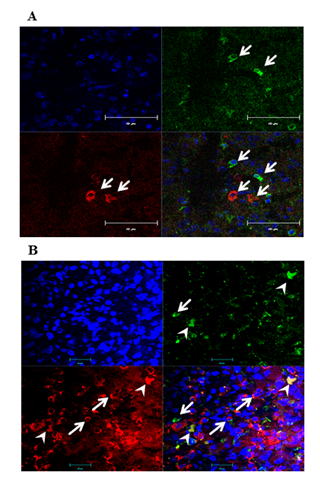 |
ルドルフ君の研究成果が、国際ジャーナルであるAnimal Reproduction Scienceに発表されました。
 |
インドネシアからの留学生のルドルフさんの論文が、世界中の繁殖研究者が読むAnimal Reproduction Scienceに発表されました。審査中に、レフェリーから非常に好意的な評価をしていただいていました。
内容は、繁殖分野において非常に重要なものです。すなわち、卵巣から分泌されたエストロジェンが、性腺刺激ホルモン(LH)や卵胞刺激ホルモン(FSH)といった生殖のために非常に重要な下垂体前葉に存在するゴナドトロフ細胞に作用をする際に、従来から知られているα型やβ型の受容体ではない、新規の受容体で細胞膜上に存在するGPR30に結合することを発見したというものです。
上のカラー写真は、ウシ下垂体前葉の組織切片に対して、蛍光2重免疫染色をして、共焦点顕微鏡で撮影した写真です。ゴナドトロフ細胞(AとBのそれぞれにおける左下のパネル内の赤色の細胞)と、GPR30を発現する細胞(AとBのそれぞれにおける右上のパネル内の緑色の細胞)と、両方を発現する細胞です(AとBのそれぞれにおける右下のパネル内の黄色の細胞)が観察されました。
さらに、エストロジェンがGPR30に結合してから、LH分泌に変化を起こすまでの時間は、わずか5分という短時間だということも確認しています。これほど短時間で影響を起こせるメカニズムは、mRNA発現には影響しない、ノンゲノミックなものだからです。従来には、数時間以上の時間が必要な、α型やβ型といった核内受容体がmRNA発現に変化をもたらす、ゲノミックなメカニズムのみが知られていました。
ルドルフさんは、材料として、ウシの下垂体を用いています。大動物であるウシは、ときとしてヒトをはじめとする様々な動物の分野にも貢献する貴重なデータをもたらしてくれますが、この論文もそのような例になります。
具体的には英語アブストラクトは次の通りです。
Expression of estradiol receptor, GPR30, in bovine anterior pituitary and effects of GPR30 agonist on GnRH-induced LH secretion
Faidiban O. Rudolf, Hiroya Kadokawa
G-protein – coupled receptor 30 (GPR30) is an estradiol receptor located on the plasma membrane, and it initiates several rapid, non-genomic signaling events. GPR30 has recently been identified in rat anterior pituitary (AP); however, little is known about the role of GPR30 in controlling luteinizing hormone (LH) secretion from gonadotropes in animals. To fill this research gap, we hypothesized that GPR30 is expressed in bovine AP and mediates estradiol inhibition of gonadotropin-releasing hormone (GnRH)-induced LH release. We confirmed the expressions of GPR30 mRNA and protein by RT-PCR, western blotting, and immunohistochemistry. We cultured bovine AP cells (n = 8) for 3 days in steroid-free conditions and then treated them with increasing concentrations (0.001 nM, 0.01 nM, 0.1 nM, 1 nM, and 10 nM) of estradiol or a GPR30-specific agonist, G1, for 5 min before GnRH stimulation. As expected, estradiol at 0.001–0.1 nM inhibited the GnRH-stimulated LH secretion. However, we found also that G1 at 0.001 nM was able to inhibit this secretion (P < 0.05). In contrast, both estradiol and G1 at higher doses were less efficient in suppressing the GnRH-stimulated LH secretion. Neither estradiol nor G1 suppressed GnRH-stimulated follicle-stimulating hormone secretion. In separate experiments, fluorescent immunohistochemistry and immunocytochemistry revealed that approximately 50% of GPR30-positive cells express LH, and about 30% of LH-positive cells express GPR30. In conclusion, GPR30 is expressed in bovine gonadotropes and other AP cells and may partially contribute to rapid negative estradiol feedback of GnRH-induced LH secretion.
この論文の詳細はこちら